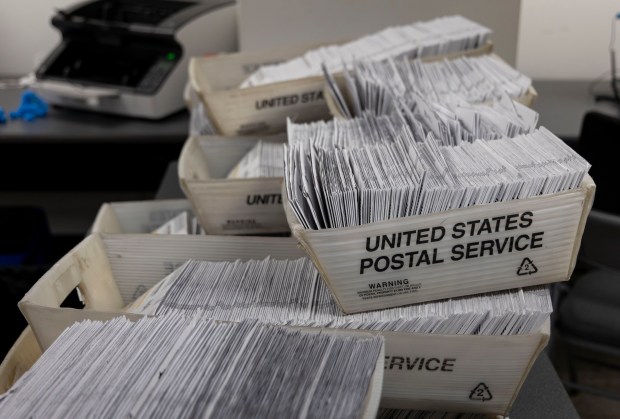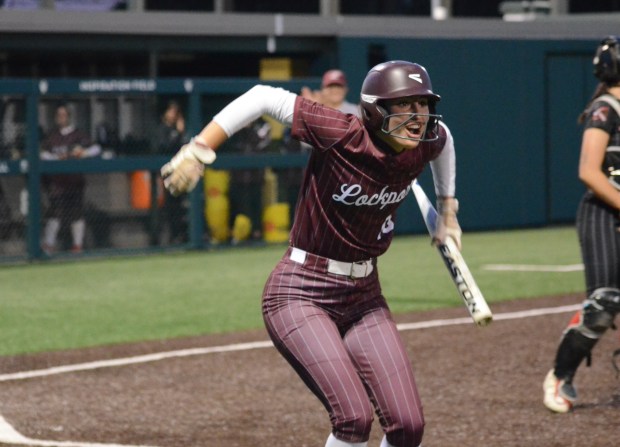Already the Chicago area’s most closely watched primary campaign this year, the race for Cook County state’s attorney devolved into some confusion and much frustration this weekend as city election officials acknowledged a mistake in communicating how many vote-by-mail ballots were being counted and results between the two Democratic candidates continued to tighten.
On Sunday evening, after the latest round of city mail-in ballots were tabulated, retired Appellate Justice Eileen O’Neill Burke still held an slight but dwindling lead over university lecturer and government official Clayton Harris III. O’Neill Burke was beating Harris 50.2% to 49.8%, with just 2,015 votes separating them, according to unofficial results from the Chicago Board of Elections and Cook County Clerk’s office.
Harris has steadily gained ground on O’Neill Burke since Election Night when she had a 10,000-vote lead with several precincts and tens of thousands of mail-in ballots awaiting to be counted. Since then, Harris has scooped up close to 60% of all mail-in ballots.
When the weekend began, her lead was nearly 6,800 votes. While her lead has decreased significantly in recent days, the question has been whether there’s enough outstanding mail-in ballots, sent by mail or dropped in official Board of Elections or clerk drop boxes by Election Day, for Harris to overtake O’Neill Burke.
That question took on added importance over the weekend when the spokesman for the Chicago elections board on Saturday evening disclosed the board had incorrectly reported the number of mail-in ballots it had received back late Monday night. The higher total number of mail-in ballots than had previously been estimated essentially moved the finish line in the state’s attorney match-up.
The Chicago Board of Elections initially reported there were 7,009 vote-by-mail ballots received via the U.S. Postal Service on Election Day. That number incorrectly excluded 9,143 mail-in ballots received via the mail so late on Monday they were considered part of the Election Day mail total, board spokesman Max Bever said. In all, therefore, the number of mail-in ballots technically received on Election Day should have been 16,152 via the mail. On top of that figure, another 14,714 mail-in ballots were received after being placed in official election board drop boxes located throughout the city, officials said.
Poll watchers for both campaigns, upon learning how many additional ballots were expected to be scanned over the weekend, caught a discrepancy between what had been publicly reported as remaining to be counted and the work election judges had left to do, attorneys for both campaigns told the Tribune.
There were no additional ballots discovered — the number that was being reported publicly by Bever did not encompass the full universe of what was left to be counted.
“This was not adding two and two from what wasn’t scanned on Monday (March 18th),” Bever told the Tribune Sunday, taking the blame for the mix-up. “It was a communications director not accurately reporting how many (vote-by-mail ballots) the board had back in hand.”
Both campaigns described frustration with the situation but neither said they feared election fraud or a conspiracy.
“I understand tensions are high. Along with dozens of volunteers, lawyers & retired judges on Team Eileen, I’ve been on-site since Wednesday watching the vote count process,” O’Neill Burke’s campaign manager, Don Black, said in a social media post on “X” late Saturday. “We’ve seen problems with communicating, not counting. Let’s please be patient while the process continues.”
Harris’ campaign manager, Alaina Hampton, said in a Saturday post on X that “if people have questions about the integrity of the election process, they’re welcome to observe the process at the (Board of Elections). I have been onsite since Wednesday and have seen nothing but transparency.”
Indeed, the weekend tallying was done under the watchful eye of attorneys and poll watchers from both campaigns as the vote count has dragged on for five days and will continue Monday at which time only between 3,500 and 4,500 total ballots from both the city and suburbs are expected to be tallied as the number of mail-ins has begun to decline. There are also other ballots to consider, including any remaining mail-in ballots that could still trickle in as well as provisional ballots, which cannot be counted until April 2.
With Sunday’s count of more than 11,600 Democratic ballots, 62% going to Harris, all of the ballots delivered late March 18 have now been counted and are included in the latest Sunday night unofficial totals.
The two are vying to replace outgoing State’s Attorney Kim Foxx. The winner will be the favorite in the November general election against Republican Bob Fioretti, a former Chicago alderman.
The 11,600 Democratic ballots were part of nearly 13,100 vote-by-mail ballots, both Democratic and Republican, counted Sunday. Not all had votes in the state’s attorney’s race.
The “vast majority” of ballots counted Sunday, Bever said, were the ones placed in Board of Elections drop boxes around the city on Election Day. Other vote-by-mail ballots received since Wednesday could also have been part of Sunday’s batch. Voters who dropped mail-in ballots on Election Day are supposed to be notified via email when the vote is counted or rejected. Vote-by-mail ballots aren’t necessarily counted in the order they are received. Those received via drop box must still be time stamped to confirm they were received on or before Election Day, for example, which takes time.
After the latest suburban numbers were released Thursday night, there were 27,000 outstanding Democratic mail-in ballots. As of Sunday evening, there are now approximately 47,000 in the city. How many of those 74,000 total outstanding ballots will be received by the respective election boards by the two-week deadline is unknown, but officials anticipate a large number of those won’t be returned.
Following Sunday’s count, approximately 2,500 Chicago ballots were working through the second step of mail-in ballot verification, known as signature review, according to both campaigns. That’s when election judges and poll watchers can compare signatures from the outside of the mail-in ballot envelopes against signatures in board records. The third step is removing the ballots from envelopes and preparing them for scanning. Between 1,000 and 2,000 Republican and Democratic ballots are also expected to be counted Monday by the Cook County Clerk.




